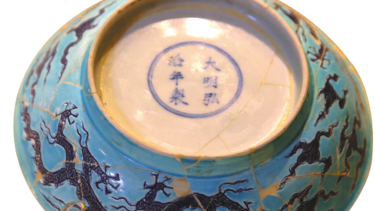
When talking about Ming Dynasty (1368-1644) porcelain, people usually focus on artifacts from the rule of Chenghua (1465-87), considered the peak of porcelain-making in China.
Since 2015, a series of exhibitions at the Palace Museum - China's former royal palace, also known as the Forbidden City - has aimed to give visitors a more comprehensive view of Ming porcelain. The third of four exhibitions recently kicked off at the museum's Zhai Gong (Hall of Abstinence) to review the lesser-known but splendid post-Chenghua porcelain ware.
The display, Imperial Porcelain from the Reigns of Hongzhi and Zhengde in the Ming Dynasty, is a comparison of porcelain pieces unearthed from the imperial kiln site in present-day Jingdezhen, Jiangxi province, and the imperial collection originally from the Palace Museum. It shows some 162 artifacts and runs through Feb 28.
Jingdezhen started its porcelain kilns exclusively serving the Ming court in 1369. Since then, it began to be known as the "porcelain capital" of China.
Only the best artifacts made in these kilns were taken to the Forbidden City, while the rest, even with the slightest flaws, were broken and buried in Jingdezhen under strict supervision.
Among the exhibits are pieces that remained intact in the palace while others were restored from broken pieces in Jingdezhen.
But Lyu Chenglong, head of the porcelain research institute at the Palace Museum and curator of the ongoing show, says some porcelain types unearthed in Jingdezhen could not be matched with any item found in the Forbidden City, and vice versa.
If you go
8:30 am-5 pm, (the closing time will be 4:30 pm every day starting from Nov 1), closed on Mondays, through Feb 28. Palace Museum, 4 Jingshan Qianjie, Dongcheng district, Beijing.



